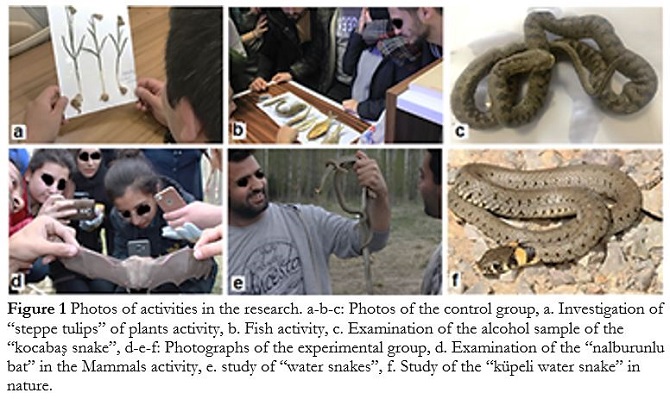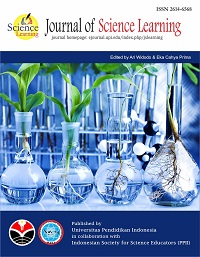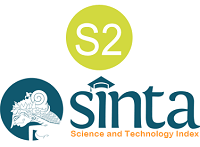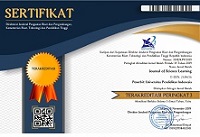
The Effect of Nature Education Activities on Biophilia Levels of Science Teacher Candidates
Abstract
Full Text:
DOWNLOAD PDFReferences
Allen, D. T. 1997. Effects of dogs on human health. Journal of the American Veterinary Medical Association, 210, 1136–1139
Aslım, G., Yiğit, A., İzmirli, S., & Yaşar, A. (2012). Hayvan koruma kavramı ve biyoetik çerçevesinde yaban hayatı koruma ve yaban hayatı geliştirme sahaları [Wildlife protection and wildlife development areas within the framework of animal protection concept and bioethics]. Kafkas Univ Vet Fak Derg, 18(4), 657-662.
Atal, D., & Koçak Usluel, Y. (2011). İlköğretim öğrencilerinin okul içinde ve dışında teknoloji kullanımları [Technology use of primary school students in and out of school]. Hacettepe Üniversitesi Eğitim Fakültesi Dergisi, 41(41), 24-35.
Bamberger, Y., & Tal, T. (2008). An experience for the lifelong journey: The long-term effect of a class visit to a science center. Visitor Studies, 2(11), 198-212. doi: 10.1080/10645570802355760
Başlar, S., & Şahin, N. (1993). Ekolojik Denge Ve Yok Olan Değerlerimiz [Ecological Balance and Our Disappearing Values]. Çevre Dergisi, 9, 15-20.
Bodur, Z. (2015). Sınıf dışı etkinliklerin Güneş sistemi ve ötesi ünitesinde ortaokul yedinci sınıf öğrencilerinin akademik başarıları, bilimsel süreç becerileri ve motivasyonları üzerine etkisi [The effect of extracurricular activities on the academic achievement, scientific process skills and motivation of secondary school seventh grade students in the Solar system and beyond unit] (Master's thesis). Yükseköğretim Kurulu Ulusal Tez Merkezi’nden edinilmiştir. (Tez No. 412440)
Bozdoğan, A. E. (2008). Planning and evaluation of field trips to informal learning environments: Case of the energy park. Journal of Theory and Practise in Education, 4(2), 282-290.
Bozdoğan, A. E., Okur, A., & Kasap, G. (2015). Planlı bir alan gezisi için örnek uygulama [Example application for a planned field trip]. Karadeniz Sosyal Bilimler Dergisi, 7(14).
Bozdoğan, A.E. (2007). Bilim ve teknoloji müzelerinin fen öğrenimindeki yeri ve önemi [The place and importance of science and technology museums in science education] (PhD thesis). Yükseköğretim Kurulu Ulusal Tez Merkezi’nden edinilmiştir. (Tez No. 207028)
Bratman, G. N., Anderson, C. B., Berman, M. G., Cochran, B., De Vries, S., Flanders, J., ... & Kahn, P. H. (2019). Nature and mental health: An ecosystem service perspective. Science advances, 5(7), eaax0903. DOI: 10.1126/sciadv.aax0903
Büyüköztürk, Ş., Çakmak-Kılıç, E., Akgün, Ö.E., Karadeniz, Ş., & Demirel, F. (2016). Bilimsel araştırma yöntemleri (20. baskı) [Scientific research methods (20th ed.)]. Ankara: Pegem Akademi.
Clements, P. T., Benasutti, K. M., & Carmone, A. (2003). Support for bereaved owners of pets. Perspectives in Psychiatric Care, 39(2), 49-54.
Cohen, J. (1988). Statistical Power Analysis for the Behavioral Sciences (2nd ed.). Hillsdale, NJ: Lawrence Earlbaum Associates
Cooney, R., & B. Dickson. (2005). The precautionary principle. Earthscan, London.
Çakmak M. (2008). Conservation of Biological Diversity by Law and Public Interest. AÜHFD, 133-166.
Çebi, H. (2018). Farklı okul dışı öğrenme ortamlarının, öğrencilerin fen bilimleri dersine karşı ilgi ve tutumlarına etkisi [The effect of different out-of-school learning environments on students' interests and attitudes towards science course] (Master's thesis). Yükseköğretim Kurulu Ulusal Tez Merkezi’nden edinilmiştir. (Tez No. 519021)
Day, J. W., Kemp, W. M., Yáñez-Arancibia, A., & Crump, B. C. (Eds.). (2012). Estuarine ecology. John Wiley & Sons.
DeWitt, J., & Osborne, J. (2010). Recollections of exhibits: Stimulated-recall interviews with primary school children about sciencecentervisits. International Journal of Science Education, 32(10), 1365-1388.
Erdogan, M. (2011). The Effects of Ecology-Based Summer Nature Education Program on Primary School Students' Environmental Knowledge, Environmental Affect and Responsible Environmental Behavior. Educational Sciences: Theory and Practice, 11(4), 2233-2237.
Erdoğan, M., & Özsoy, A. M. (2007). Graduate students’ perspectives on the human and environment relationship. Türk Fen Eğitimi Dergisi, 4(2), 21-30.
Erdoğan, M., Bahar, M., & Uşak, M. (2011). 007 yılında uygulanmaya başlanan lise 9-12. sınıf biyoloji dersi ögretim programlarında çevre eğitimi [Environmental education in classroom biology curriculum]. Kuram ve Uygulamada Egitim Bilimleri, 12(3), 2217-2235.
Erten, S. (2004). Çevre Eğitimi ve Çevre Bilinci Nedir, Çevre Eğitimi Nasıl Olmalıdır? [What is Environmental Education and Environmental Awareness, How Environmental Education Should Be?]. Çevre ve İnsan Dergisi, Çevre ve Orman Bakanlığı Yayın Organı, 65-66.
Farmer, J., Knapp, D., & Benton, M. G. (2007). An elementary school environmental education field trip: long-term effects on ecological and environmental knowledge and attitude development. The Journal of Environmental Education, 38(3), 33-42.
Frumkin, H. (2001). Beyond toxicity: human health and the natural environment. American Journal of Preventive Medicine, 20, 234–240.
Glock, J., Meyer, M., & Wertz, S. (1999). Discovering the naturalist intelligence: Science in the schoolyard. Zephyr Press.
Güler, A. (2011). Planlı bir müze gezisinin ilköğretim öğrencilerinin tutumuna etkisi [The effect of a planned museum visit on the attitude of primary school students]. İlköğretim Online, 10(1), 169-179.
Güler, T. (2010). Ekoloji temelli bir çevre eğitiminin öğretmenlerin çevre eğitimine karşı görüşlerine etkileri [The effects of an ecology-based environmental education on teachers' views on environmental education]. Eğitim ve Bilim, 34(151).
Humberstone, B., & Stan, I., (2010). Outdoor learning: primary pupils’ experiences and teachers’ interaction in outdoor learning. International Journal of Primary, Elementary and Early Years Education, 39(5), 529-540. doi: 10.1080/03004279.2010.487837
Jarvis, T., & Pell, A. (2002). The effect of the challenger experience on elementary children’s attitudes to science. Journal of Research in Science Teaching, 39(10), 979-1000.
Jarvis, T., & Pell, A. (2005). Factors influencing elementary school children's attitudes toward science before, during and after a visit to the UK. National Space Centre. Journal of Research in Science Teaching, 42(1), 53-83. doi: 10.1002/tea.20045
Johnson, R. A., & Meadows, R. L. (2002). Older Latinos, pets, and health. Western Journal of Nursing Research, 24(6), 609-620. doi: 10.1177/019394502320555377
Kaplan, R., & Kaplan, S. (1989). The experience of nature: A psychological perspective. Cambridge university press.
Karagöz A., Zencirci N., Tan A., Taşkın T., Köksel H., Sürek M., Toker C. & Özbek K. (2010). Bitki Genetik Kaynaklarının Korunması ve Kullanımı [Conservation and Use of Plant Genetic Resources]. Türkiye Ziraat Mühendisliği VII Teknik Kongresi. Bildiriler (I): 11-15 Ocak, Ankara (p. 155-177).
Karagöz, A., Özbek, K., & Sarı, N. (2016). Türkiye’nin bitkisel biyolojik çeşitliliğinin korunması ve sürdürülebilir kullanımına ilişkin sorunlar ve çözüm önerileri [Problems and solutions regarding the conservation and sustainable use of Turkey's plant biodiversity]. Tarla Bitkileri Merkez Araştırma Enstitüsü Dergisi, 88-99.
Katcher, A., & Wilkins, G. (1993). Dialogue with animals: Its nature and culture. The biophilia hypothesis, 173-197.
Keleş, Ö. (2011). Fen öğretiminde okul dışı öğrenme ortamları [Out-of-school learning environments in science teaching]. In C. Laçin-Şimşek (Ed.), Doğa eğitimleri [Nature education] (p. 65-84). Ankara: Pegem Akademi.
Keleş, Ö., Uzun, N., & Uzun, F.V. (2010). Öğretmen adaylarının çevre bilinci, çevresel tutum, düşünce, ve davranışlarının doğa eğitimi projesine bağlı değişimi ve kalıcılığının değerlendirilmesi [Evaluation of the change and permanence of teacher candidates' environmental awareness, environmental attitudes, thoughts and behaviors depending on the nature education project]. Elektronik Sosyal Bilimler Dergisi, 9(32), 384-401.
Kellert, S. R. (2012). Birthright: People and nature in the modern world. Yale University Press.
Kellert, S. R. (2018). Nature by design: The practice of biophilic design. Yale University Press.
Kellert, S. R., Heerwagen, J., & Mador, M. (2011). Biophilic design: the theory, science and practice of bringing buildings to life. John Wiley & Sons.
Kurdoğlu, O. (2007). Dünyada doğayı koruma hareketinin tarihsel gelişimi ve güncel boyutu [The historical development and current dimension of the nature conservation movement in the world]. Artvin Çoruh Üniversitesi Orman Fakültesi Dergisi, 8(1), 59-76.
Lakin, L. (2006). Science Beyond The Classroom. Journal of Biological Education, 40(2), 88-90.
Lopez, R.P. (2012). The built environment and public health (1st Ed.). San Francisco: Jossey-Bass.
Lumber, R., Richardson, M., & Sheffield, D. (2017). Beyond knowing nature: Contact, emotion, compassion, meaning, and beauty are pathways to nature connection. PloS one, 12(5), 1-24. doi: 10.1371/journal.pone.0177186
Lust, E., Ryan-Haddad, A., Coover, K., & Snell, J. (2007). Measuring clinical outcomes of animal-assisted therapy: Impact on resident medication usage. The Consultant Pharmacist, 22(7), 580-585.
Martınez-Lopez, B., Montes, C. & Benayas, J. (2007). The non-economic 'motives behind the willingness to pay for biodiversity conservation. Biological Conservation, 139, 67–82.
Meydan, A., Bozyiğit, R., & Karakurt, M. (2012). Ekoloji Temelli Doğa Eğitimi Projelerinin Katılımcı Beklentilerini Karşılama Düzeyleri [The Levels of Meeting Participant Expectations of Ecology-Based Nature Education Projects]. Marmara Coğrafya Dergisi, 25, 238-255.
Miller, J. R. (2005). Biodiversity conservation and the extinction of experience. Trends in Ecology and Evolution, 20, 430–434.
Ozaner, F. S. (2004). Türkiye’de okul dışı çevre eğitimi ne durumda ve neler yapılmalı? [What is the situation of out-of-school environmental education in Turkey and what should be done?]. In The V. National Ecology and Environment Congress (pp. 67-98). Abant-Bolu: Abant İzzet Baysal University and İzmir Biologists Association.
Öner, Z. (2018). Çevre eğitimine yönelik hazırlanan formal ve informal uygulamaların akademik başarı, tutum ve öğrenci kazanımları açısından incelenmesi [Examination of formal and informal practices prepared for environmental education in terms of academic achievement, attitude and student achievements] (PhD thesis). Yükseköğretim Kurulu Ulusal Tez Merkezi’nden edinilmiştir. (Tez No. 528448)
Özmen, H. (2014). Deneysel araştırma yöntemleri [Experimental research methods]. In M. Metin (Ed.), Kuramdan uygulamaya eğitimde bilimsel araştırma yöntemleri [Scientific research methods in education from theory to practice] (pp. 47-76). Ankara: Pegem Akademi Yayıncılık.
Özür, N. (2010). Sosyal bilgiler dersinde sınıf dışı etkinliklerin öğrenci başarısına etkisi [The effect of out-of-class activities on student achievement in social studies course] (PhD thesis). Yükseköğretim Kurulu Ulusal Tez Merkezi’nden edinilmiştir. (Tez No. 279700)
Özyıldırım, H., & Durel, E. (2017). Okul dışı öğrenme ve okul dışı öğrenme ortamları. Balkan Eğitim Araştırmaları [Out-of-school learning and out-of-school learning environments. Balkan Educational Research]. Edirne: Trakya Üniversitesi.
Perkins, H. E. (2010). Measuring love and care for nature. Journal of environmental psychology, 30(4), 455-463.
Ramey-Gassert, L. (1997). Learning science beyond the classroom. The Elementary School Journal, 97(4), 433-450.
Sala, O. E. (2009). Biodiversity change and human health: from ecosystem services to spread of disease. Island Press.
Samways, M. J. (2007). Rescuing the extinction of experience. Biodiversity Conservation, 16, 1995–1997.
Sandford, R., Duncombe, R., & Armour, K. (2008). The role of physical activity/sport in tackling youth disaffection and anti-social behaviour. Educational Review, 60(4), 419-435. doi: 10.1080/00131910802393464
Sefalı, A. (2019). Doğa eğitimi etkinliklerinin fen bilgisi öğretmen adaylarının biyofili seviyelerine etkisinin araştırılması [Investigation of the effects of nature education activities on the biophilia levels of pre-service science teachers] (PhD thesis). Atatürk üniversitesi, Eğitim bilimleri Enstitüsü.Erzurum.
Shore, E. R., Douglas, D. K., & Riley, M. L. (2005). What's in it for the companion animal? Pet attachment and college students' behaviors toward pets. Journal of Applied Animal Welfare Science, 8(1), 1-11. doi: 10.1207/s15327604jaws0801_1
Simaika, J. P., & Samways, M. J. (2010). Biophilia as a universal ethic for conserving biodiversity. Conservation Biology, 24(3), 903-906.
Stokes, D. L. (2006). Conservators of experience. BioScience, 56, 6–7.
Tidball, K. G. (2012). Urgent biophilia: human-nature interactions and biological attractions in disaster resilience. Ecology and Society, 17(2).
Turner, W. R., Nakamura, T., & Dinetti, M. (2004). Global urbanization and the separation of humans from nature. Bioscience, 54(6), 585-590.
TÜBİTAK. (2018). 4004-Doğa eğitimi ve bilim okullarıdestekleme programı [Supporting program for nature education and science schools]. Retrieved from https://www.tubitak.gov.tr/sites/default/files/13209/4004_cagri_metni_27072018.pdf
Wild, R., McLeod, C., & Valentine, P. (2008). Sacred natural sites: guidelines for protected area managers (No. 16). IUCN.
Wilson, E, O. (2007). Biophilia and the conservation ethic. Evolutionary perspectives on environmental problems. Washington DC. 249-257.
Yerkes, R., & Haras, K. (1997). Outdoor Education and Environmental Responsibility. ERIC Digest.
Yin, J., Yuan, J., Arfaei, N., Catalano, P. J., Allen, J. G., & Spengler, J. D. (2020). Effects of biophilic indoor environment on stress and anxiety recovery: A between-subjects experiment in virtual reality. Environment International, 136, 105427.
Young, J., Watt, A., Nowicki, P., Alard, D., Clitherow, J., Henle, K., ... & Niemela, J. (2005). Towards sustainable land use: identifying and managing the conflicts between human activities and biodiversity conservation in Europe. Biodiversity & Conservation, 14(7), 1641-1661.
DOI: https://doi.org/10.17509/jsl.v4i4.33434
Refbacks
- There are currently no refbacks.
Copyright (c) 2021 Abdurrahman Sefalı, Esra Ozay Kose

This work is licensed under a Creative Commons Attribution-ShareAlike 4.0 International License.


Jl. Dr. Setiabudhi 229 Bandung 40154, West Java, Indonesia










